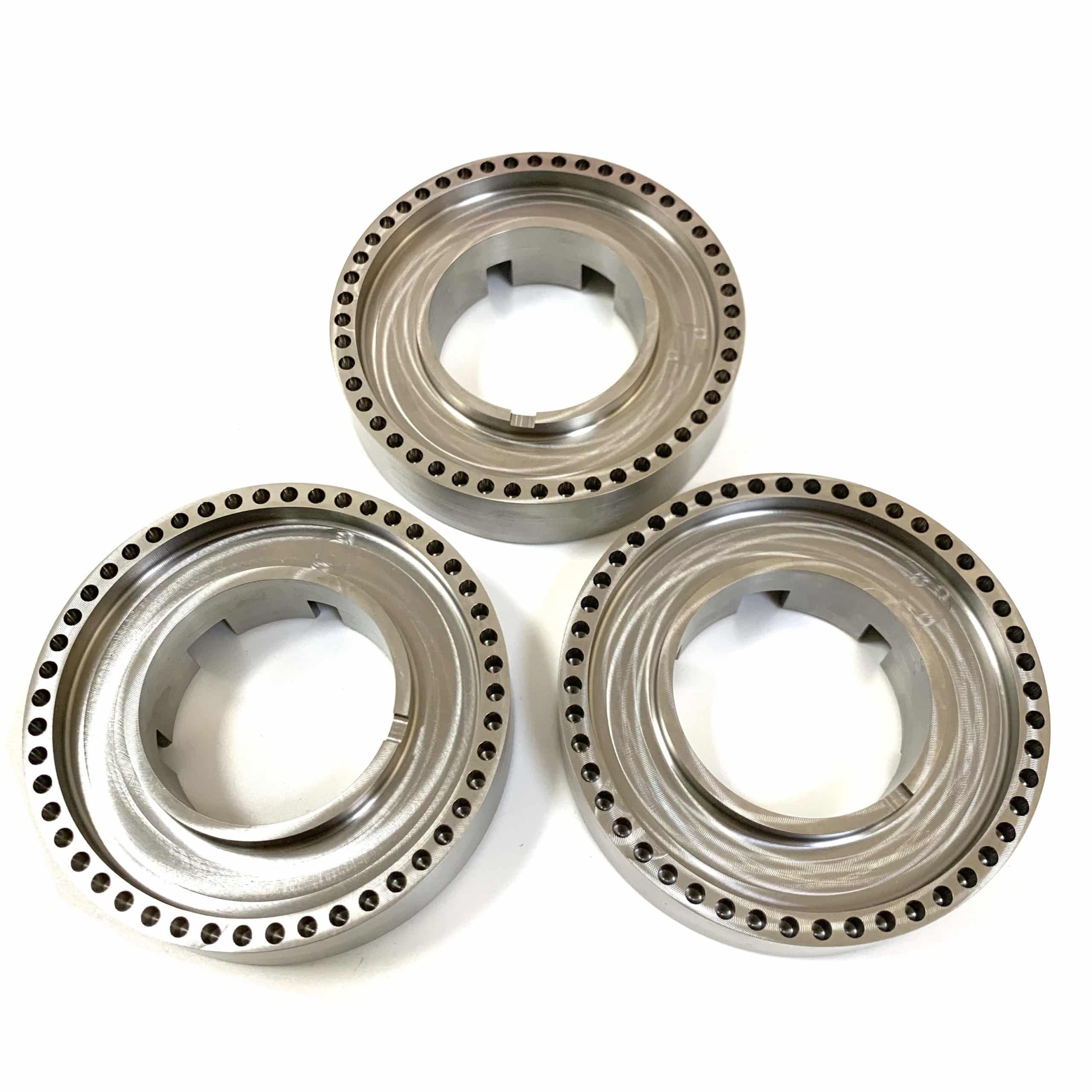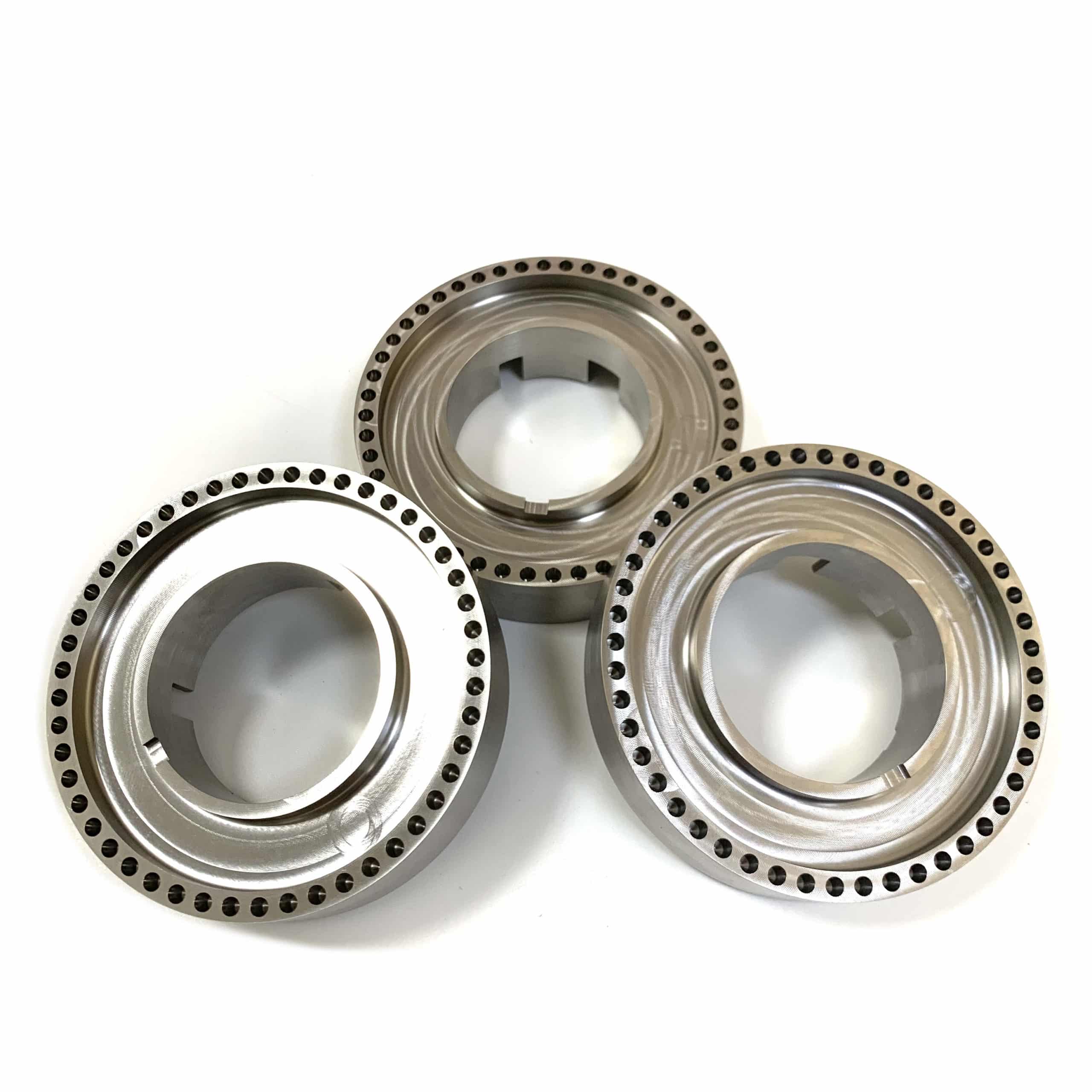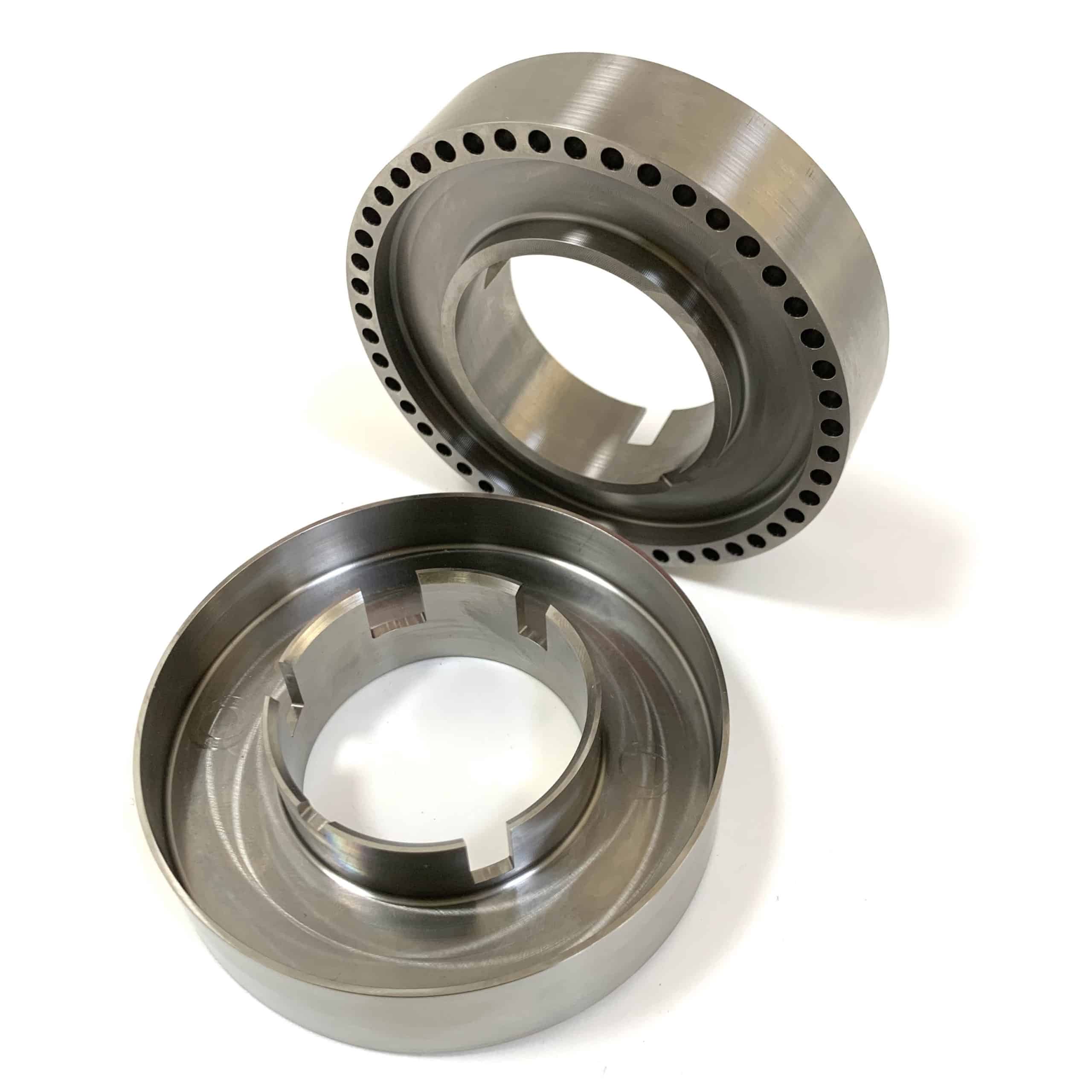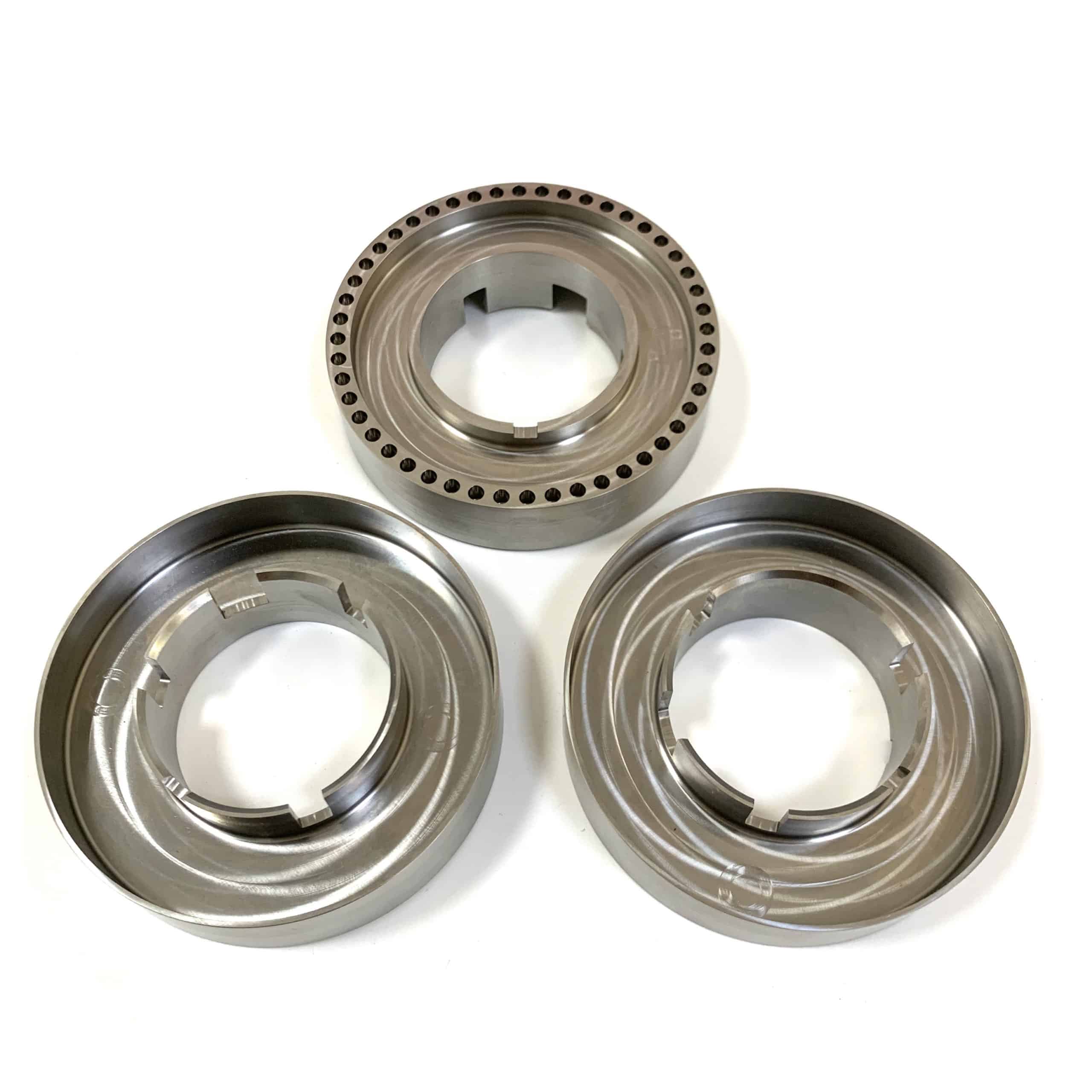Description
Product Material: Ti-6Al-4V, Grade 5
Product Name: Aircraft Brake Housing
Introduction:
The aircraft brake component is a braking device installed on the wheel of the aircraft. Its main function is to generate braking torque, absorb the kinetic energy of the aircraft’s landing roll, decelerate the aircraft, and shorten the roll distance.
The structure of the brake device is mostly disc type, which is composed of a brake disc, a brake housing, a cylinder seat piston assembly, and an automatic gap adjustment and return force mechanism.
When braking, the working medium (hydraulic oil) from the braking system enters the cylinder block and pushes the piston so that the alternately arranged moving discs and static discs are compressed to generate friction torque to brake the aircraft.
When the brake is released, the compressed return spring is used to reset, and the dynamic and static discs are disengaged.
Titanium alloys are mainly used to make compressor parts for aerospace engines, and structural parts of rockets, missiles, and high-speed aircraft.
The density of titanium alloy is about 4.51g/cm³, which is only 60% of steel. The strength of titanium alloy exceeds that of many alloy structural sheets of steel, and parts with high unit strength, good rigidity, and lightweight can be produced.
Titanium alloys are used in aircraft engine components, skeletons, fasteners, and landing gear.
Recommended: CNC Turning Services In China For Aerospace Applications
Titanium Alloys Processing Mechanism and Phenomenon
Because of an insufficient understanding of titanium alloys, most factories consider titanium alloys to be an extremely difficult material to process.
Today, Yijin Hardware experts analyze the processing mechanism and phenomenon of titanium alloys for everyone.
The first thing to talk about is the physical phenomenon of titanium alloy processing. Although the cutting force of titanium alloy is only slightly higher than that of steel with the same hardness, the physical phenomenon of processing titanium alloy is much more complicated than that of processing steel, which makes titanium alloy.
The degree of difficulty of processing has skyrocketed.
Effect of Thermal Conductivity of Titanium Alloy on Machining
The thermal conductivity of most titanium alloys is very low, only 1/7 of steel and 1/16 of aluminum.
Therefore, the heat generated in the process of cutting titanium alloy will not be quickly transferred to the workpiece or taken away by the chips but will accumulate in the cutting area, and the temperature generated can be as high as 1000 ℃ or more, which will cause the cutting edge of the tool to wear, crack and generate rapidly.
Built-up edge, the rapid appearance of a worn edge, in turn, generates more heat in the cutting area, further reducing tool life.
The high temperature generated during the cutting process also destroys the surface integrity of the titanium alloy parts, resulting in a decrease in the geometric accuracy of the parts and the occurrence of work hardening.
The elasticity of titanium alloys can be beneficial for part performance, but the elastic deformation of the workpiece during cutting is the main cause of vibration.
The cutting pressure causes the “elastic” workpiece to move away from the tool and bounce so that the friction between the tool and the workpiece is greater than the cutting action.
The friction process also generates heat, aggravating the problem of poor thermal conductivity of titanium alloys.
This problem is even more serious when processing thin-walled or ring-shaped parts that are easily deformed. It is not an easy task to process titanium alloy thin-walled parts to the expected dimensional accuracy.
When the workpiece material is pushed away by the tool, the local deformation of the thin wall has exceeded the elastic range and plastic deformation occurs, and the material strength and hardness of the cutting point increase significantly.
At this point, machining at the previously determined cutting speed becomes too high, further resulting in sharp tool wear.
It can be said that “heat” is the fundamental factor that causes the difficulty of processing titanium alloys.
How Do Choose and Use Tools Reasonably in Titanium Alloy Processing?
As a leader in the CNC industry, Yijin Hardware has carefully sorted out process know-how for processing titanium alloys and shared it with the entire industry.
- Inserts with positive geometry are used to reduce cutting forces, cutting heat, and deformation of the workpiece.
- Keep a constant feed to avoid the hardening of the workpiece, the tool should always be in the feed state during the cutting process, and the radial cutting amount should be 30% of the radius during milling.
- High-pressure and large-flow cutting fluid is used to ensure the thermal stability of the machining process and prevent workpiece surface degeneration and tool damage due to excessive temperature.
- Keep the blade edge sharp, dull tools are one of the causes of heat build-up and wear, which can easily lead to tool failure.
- Work in the softest state of the titanium alloy as possible, as the material becomes more difficult to process after hardening, and the heat increases the strength of the material and increases the wear of the insert.
- Use a large tip radius or chamfering cut to bring as much of the blade into the cut as possible. This reduces cutting force and heat at every point, preventing localized breakage. When milling titanium alloys, among the cutting parameters, the cutting speed has the greatest influence on the tool life VC, followed by the radial engagement (milling depth).
When the hardness of titanium alloy is greater than HB350, it is particularly difficult to cut, and when it is less than HB300, the phenomenon of sticking is easy to occur, and it is also difficult to cut. Therefore, the titanium processing problem can be solved from the blade.
The wear of the insert groove in the machining of titanium alloys is the local wear of the back and front in the direction of the depth of cut, which is often caused by the hardened layer left by the previous machining.
The chemical reaction and diffusion of the tool and the workpiece material at a processing temperature of more than 800 ° C are also one of the reasons for the formation of groove wear.
During the processing process, the titanium molecules of the workpiece accumulate in the front of the blade and are “welded” to the blade edge under high pressure and high temperature, forming a built-up edge.
When the built-up edge peels off the cutting edge, it takes away the carbide coating of the insert, so titanium machining requires special insert materials and geometries.
It is worth mentioning that since titanium alloys generate high heat during processing, a large amount of high-pressure cutting fluid must be sprayed on the cutting edge in a timely and accurate manner to quickly remove the heat.
There are also milling cutters specially used for titanium alloy machining on the market today, and their unique structure can be better suited for titanium alloy machining.
At present, all countries are developing low-cost and high-performance new titanium alloys, striving to make titanium alloys enter the civilian industrial field with huge market potential, and my country has spared no effort to move forward in this field.
It is believed that through the joint efforts of all industry professionals, the processing of titanium alloys will no longer be a problem in the future, but will become a sharp blade for the development of my country’s manufacturing industry, and will overcome difficulties for the development of the entire industry.
 Call Us Today! (+86) 188-2253-7569
Call Us Today! (+86) 188-2253-7569


